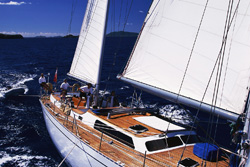| Weather Fact: | Snowflakes falling at 2-4 mph can take about 1 hr to reach the ground. |
Across the globe air is constantly moving, circulating, rising and falling.

In the previous chapter we’ve looked at the relationship between different pressure systems, temperature and speed, and how these properties affect air movement.
Although wind speed and direction can alter from one moment to the next on a localised level, there are a series of defined air patterns which affect the entire surface of the globe.
A key factor in these defined air patterns is Geographic Location.
This chapter explores some of the unique winds which occur in different parts of the world, and the effect they have on the climate and landscape around them.
Trade Winds form within the Tropics, following the line of the Equator. As wind flows outward away from areas of subtropical high pressure, it encounters the Coriolis Effect, which is caused by the rotation of the Earth. This rotational force causes the wind in the Northern Hemisphere to move from the East towards the West above the subtropical high, and from the West towards the East below the subtropical high.
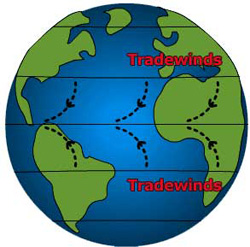
The opposite is true in the Southern Hemisphere.
So, in the Northern Hemisphere we find winds blowing from East to West and in the Southern Hemisphere we also find winds blowing East to West.
Trade winds blow from the northeast in the Northern Hemisphere and from the Southeast in the Southern Hemisphere, and meet at the equator in an area of low pressure, which is known as the Doldrums. The Doldrums lie at 5° North and 5° South of the Equator the area is renowned for its light, still wind conditions.
These easterly winds have been termed Trade Winds as they have historically been used by sailing ships and ocean going vessels to cross the Pacific and Atlantic Oceans.
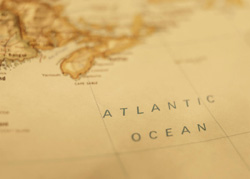
As far back as the 15th Century, these winds have been an important navigational and directional force, creating an easy passage of travel across the Atlantic Ocean.
Vital trading routes were established between Europe and the Americas during the 18th Century, and allowed England’s Merchant Navy to travel across the Atlantic and establish strong commercial relationships with countries along the Equator.
Trade Winds are associated with the movement of tropical storms that form over the Atlantic and Pacific. Their force pushes these storms towards land, where they can cause mayhem and destruction.
Trade Winds also transport thousands of tonnes of sand and dust across the Oceans from Africa all the way to the Caribbean and areas of North America.
Westerlies
Westerly winds form between 30° and 60° latitude in both the Northern and Southern Hemispheres. These winds originate in the West both sides of the Equator, and blow from Southwest in the Northern hemisphere and from Northwest in the Southern hemisphere.
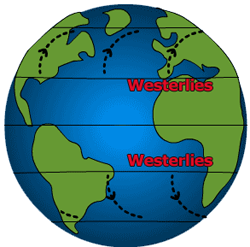
Westerly winds have a significant impact on the Ocean currents of the Atlantic and Pacific Oceans.
The persistent strong winds blowing west to east drive the waters on the eastern edge of the ocean, pushing warm tropical water towards the northern and southern Polar regions.
Within the Indian Ocean, the north-westerly winds are termed the Roaring Forties. First documented in circa 1610, these strong and enduring winds assisted sailors in their journey across the Indian Ocean on the notorious Spice Route.
As well as influencing the ocean currents, the Westerlies are responsible for producing Jet Streams. Described as a long, meandering wind, Jet Stream winds circle the Earth within the lower and upper atmosphere of both the Northern and Southern hemispheres. They are often as much as 3,000 miles long, and travel at an average speed of approximately 90km per hour.
There are 2 Jet Streams in each hemisphere:
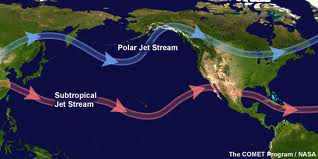
- Polar Jet Stream – The Polar Jet Streams are the stronger of the 2 wind’s, and typically sit between 7 and 12kms above sea level
- Subtropical Jet Stream – The Sub Tropical Jet Streams are weaker, and sit between 10 and 16kms above sea level
Jet streams have a significant impact on the Aviation industry, as they can both delay and speed up flight times. Commercial jets and holiday makers alike will be affected by the position of the different jet streams as they make for their destination.
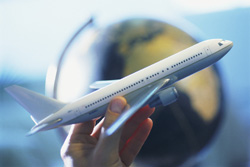
Jet streams are also a key factor in predicting and forecasting future weather patterns.
The location and speed of the Jet Stream can have dramatic effects on the weather across an entire continent, therefore meteorologists use this observation to formulate short to medium term weather reports.
Polar Easterlies
The Polar Easterlies are intensely cold, dry winds which originate at the North and South Poles.
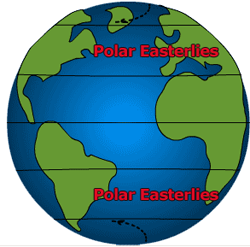
These prevailing winds blow from the East, and contribute greatly to the Polar climate.
The Polar Easterlies blow cold dry air outwards from the poles towards the Equator. These cold winds meet the warmer winds of the Westerlies and mix to form moist winds which bring rain, snow and storms to the continents of the world.
Polar Easterlies are not as forceful or consistent as the Westerly winds, and are much more prominent in Winter at 60° latitude and above.
Did You Know?The Doldrums were known to stop the progress of sailing ships for days and even weeks because of the lack of wind
Did You Know?There are no Trade Winds in North Indian Ocean.
Did You Know?The Jet Stream travels at an average speed of 35mph in Summer and 75mph in the Winter
Did You Know?Jupiter‘s atmosphere has multiple Jet Streams which give the planet its distinctive colour bands

